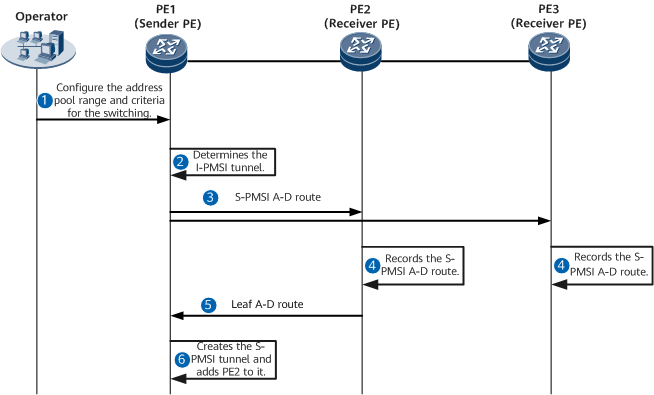BIERv6 S-PMSI Tunnel Establishment
An S-PMSI tunnel connects some PEs in the same MVPN and is used to transmit VPN data only to the PEs that require the data. If no multicast user requests multicast data from the corresponding (S, G) in the VPN connected to a receiver PE, the receiver PE will not receive such data. Compared with an I-PMSI tunnel, an S-PMSI tunnel prevents redundant data from being forwarded, thereby conserving network bandwidth.
Figure 1 shows the process of establishing a BIERv6 S-PMSI tunnel. PE1 is the sender PE, and PE2 and PE3 are receiver PEs. PE2 has receivers in the connected VPN, meaning that some users are in the (S, G) corresponding to a received multicast packet, whereas PE3 has no receivers in the connected VPN.
Table 1 describes the process of establishing a BIERv6 S-PMSI tunnel.
Step |
Device |
Description |
|---|---|---|
1 |
PE1 |
PE1 must be configured with an address pool range and criteria for switching from an I-PMSI tunnel to an S-PMSI tunnel. This includes the multicast group address pool, BSL, maximum number of S-PMSI tunnels that can be dynamically established, forwarding rate threshold for the switching, and a delay for the switching. |
2 |
PE1 |
After PE1 receives a C-multicast packet, it determines the I-PMSI tunnel based on the (C-S, C-G) or (C-*, C-G) entry carried in the packet. If the address pool range and criteria for the I-PMSI-to-S-PMSI tunnel switching are met, PE1 automatically establishes an S-PMSI tunnel. If a delay for the switching has been set, multicast traffic is not switched to the S-PMSI tunnel until the delay timer expires. |
3 |
PE1 |
PE1 sends an S-PMSI A-D route carrying PMSI tunnel information to PE2 and PE3. In the route, the Leaf Information Require flag is set to 1, instructing PE2 and PE3 to reply with a BGP Leaf A-D route if they want to join the S-PMSI tunnel. |
4 |
PE2 and PE3 |
After receiving the S-PMSI A-D route, PE2 and PE3 record the route locally and check whether they have receivers in the connected VPN. PE2 determines that it has such receivers, and PE3 determines that it has no such receivers. |
5 |
PE2 |
Because it has receivers in the connected VPN, PE2 sends a Leaf A-D route to PE1. The route carries the PTA. |
6 |
PE1 |
After receiving the Leaf A-D route from PE2, PE1 records PE2 as a receiver PE and sets the bit position of PE2 in the BIERv6 BitString to 1. PE2 then joins the BIERv6 S-PMSI tunnel. |
If VPN receivers request multicast data from PE3 after a while, PE3 sends a Leaf A-D route to PE1. After receiving the route, PE1 updates the receiver PE set and generates a new BIERv6 BitString. PE3 then joins the BIERv6 S-PMSI tunnel.
